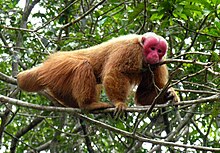Uakari
| Uakari[1] | |
|---|---|

| |
| Bald uakari (Cacajao calvus) | |
| Scientific classification | |
| Domain: | Eukaryota |
| Kingdom: | Animalia |
| Phylum: | Chordata |
| Class: | Mammalia |
| Order: | Primates |
| Suborder: | Haplorhini |
| Infraorder: | Simiiformes |
| Family: | Pitheciidae |
| Subfamily: | Pitheciinae |
| Genus: | Cacajao Lesson , 1840
|
| Type species | |
Simia melanocephalus
, 1812 | |
| Species | |
|
| |
Uakari (UK: /wəˈkɑːri/,[2] US: /wɑː-/)[3] is the common name for the New World monkeys of the genus Cacajao. Both the English and scientific names are believed to have originated from indigenous languages.[4]
The uakaris are unusual among New World monkeys in that the tail length (15–18 cm) is substantially less than their head and body length (40–45 cm). Their bodies are covered with long, loose hair but their heads are bald. They have almost no subcutaneous fat, so their bald faces appear almost skull-like. Like their closest relatives the saki monkeys, they have projecting lower incisors. These monkeys have the most striking red facial skin of any primate. Females choose their mates based on how red the male's face is. Evidence suggests that the red facial coloration reflects the health of the primate.[5]
The four species of uakari currently recognized are all found in the north-western
They have been observed both in small groups and in larger troops of up to 100. When traveling through the forest they move in the lower branches of the trees, though when foraging they also go up to the canopy. They mostly
Uakari are found in neotropical
A phylogeographic reconstruction found that the concestor of living uakari dates to 1.7 million years ago, in the Solimões River, whence they spread and diversified following intermittent river rearrangements.[8]
Species
There are four species in this genus:[1][9]
- Genus Cacajao
- Bald uakari or red uakari, C. calvus
- Cacajao calvus calvus
- Cacajao calvus ucayalii
- Cacajao calvus rubicundus
- Cacajao calvus novaesi
- Bald uakari or red uakari, C. calvus
- Black-headed uakari species group
- Golden-backed or black-headed uakari, Cacajao melanocephalus
- Aracá uakari, Cacajao ayresi*
- Neblina uakari, Cacajao hosomi*
In 2014 Ferrari et al. proposed an alternative taxonomy for the C. melanocephalus group which recognizes the Aracá uakari as a subspecies of the golden-backed uakari, and also recognized Cacajao ouakary as a separate species, whereas current consensus is that C. ouakary is a junior synonym of C. melanocephalus.[10][11] This revision is not universally accepted.[12]

References
- ^ OCLC 62265494.
- ^ "uakari". Lexico UK English Dictionary. Oxford University Press. Archived from the original on November 23, 2021.
- ^ "uakari". Merriam-Webster.com Dictionary.
- ISSN 1413-4705.
- PMID 27053753.
- ^ Wolfe, A. (1997) Primates, San Francisco: Chronicle Books, p. 159
- ^ a b Gron, K.J. (July 21, 2008). "Primate Factsheets: Uakari (Cacajao) Taxonomy, Morphology, & Ecology". Retrieved July 1, 2012.
- ISSN 0305-0270.
- S2CID 26561719. Archived from the original(PDF) on 2008-10-31.
- PMID 25283664.
- ^ "Cacajao". ASM Mammal Diversity Database. Retrieved 2019-07-24.
- ^ "Cacajao". ITIS. Retrieved 2 September 2022.
